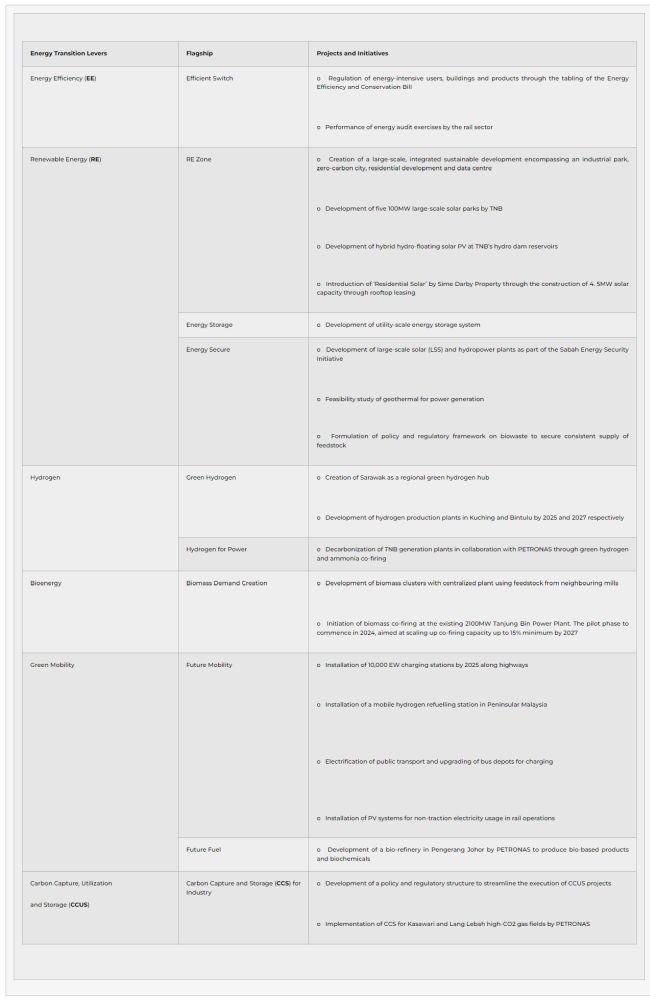The Ministry of Economy has recently launched the National Energy Transition Roadmap ("NETR") Part 1 as a step towards reaching Malaysia's net-zero emission target by transitioning the country into a more sustainable energy landscape. The NETR is being led by a steering and technical committee comprising of representatives from various ministries, agencies and private sector companies.
The first phase of the NETR has identified 10 flagship catalyst projects and initiatives based on 6 energy transition levers: (1) energy efficiency; (2) renewable energy; (3) hydrogen; (4) bioenergy; (5) green mobility; and (6) carbon capture, utilization, and storage. It is anticipated that these projects and initiatives will generate 23,000 high-impact jobs, RM25 billion in investments and reduce 10,000 gigagrams of CO2 annually.
By 2050, the NETR is anticipated to open up energy transition investment opportunities of between RM435 billion to RM1.85 trillion in value. Moreover, the second phase of the NETR is expected to be completed in the second half of 2023 and is aimed at establishing a low-carbon pathway, energy mix, and emission reduction target for the energy sector.
Guiding Principles and Policies
The NETR has 4 guiding principles in this transition towards sustainable energy. These principles are aimed at:
- aligning the energy sector with the country's sustainable development goals and commitments;
- emphasising a just and inclusive transition that addresses challenges faced by low-income and vulnerable populations;
- underscoring effective governance and collaboration with state governments; and
- creating meaningful employment and economic opportunities, especially for small and medium enterprises.
Corresponding to the launch of the NETR, several policy decisions have been made, including:
- stretching the country's installed renewable energy capacity from 40% in 2035 to 70% by 2050;
- utilising the concept of a self-contained system according to the "willing buyer, willing seller" principle to encourage investment in the value chain and diversify renewable energy programmes;
- increasing the installation of solar systems on government buildings; and
- allowing cross-border renewable energy trade through the establishment of a central electricity exchange system that will be operated by a single-market aggregator.
Flagship Catalyst Project and Initiatives
The 10 flagship catalyst projects and initiatives introduced under the NETR encompass diverse approaches in showcasing the range of technologies and solutions required for the energy transition. Consequently, distinct entities will lead each approach, highlighting their unique contributions to Malaysia's energy transition advancements as outlined below:
EXPAND ARTICLE

The policy document makes clear that the projects and initiatives will be championed and implemented by designated public and private sectors. Furthermore, in relation to the envisioned RE Zone, Khazanah's UEM Group has signed an MoU with Itramas Corp. to develop a 1GW solar PV power plant to be integrated into the RE industrial park.1 The power plant is expected to be the largest of its kind in the ASEAN region.2
Final Thoughts
The introduction of the NETR is a clear depiction of the Government's commitment to meeting the country's net-zero target. Albeit comprising interim measures, the projects and initiatives introduced hold the potential of transforming the country's existing renewable energy landscape, creating economic opportunities, improving livelihood and accelerating the country's energy transition on a large scale. Phase 2 of the NETR will likely provide further clarity on the Government's future plans and measures to implement the NETR.
Further details in relation to the NETR are described in the policy document "National Energy Transition Roadmap Part 1: Flagship Catalyst Projects and Initiatives", which can be viewed here.
If you have any queries, please contact Senior Associate, Joyce Ong (oky@lh-ag.com) or her team Partner, Steven SY Tee (syt@lh-ag.com
Footnotes
1. 'MIDA, Khazanah's UEM Group to partner local and foreign investors to develop 1GW solar plant – Asean's largest' (MIDA, 27 July 2023) [https://www.mida.gov.my/mida-news/khazanahs-uem-group-to-partner-local-and-foreign-investors-to-develop-1gw-solar-plant-aseans-largest/] accessed 10 August 2023
2. Power Technology, 'UEM Group to build 1GW solar project in Malaysia' (Power Technology, 28 July 2023) [https://www.power-technology.com/news/uem-build-1gw-solar-malaysia/] accessed 10 August 2023
The content of this article is intended to provide a general guide to the subject matter. Specialist advice should be sought about your specific circumstances.
